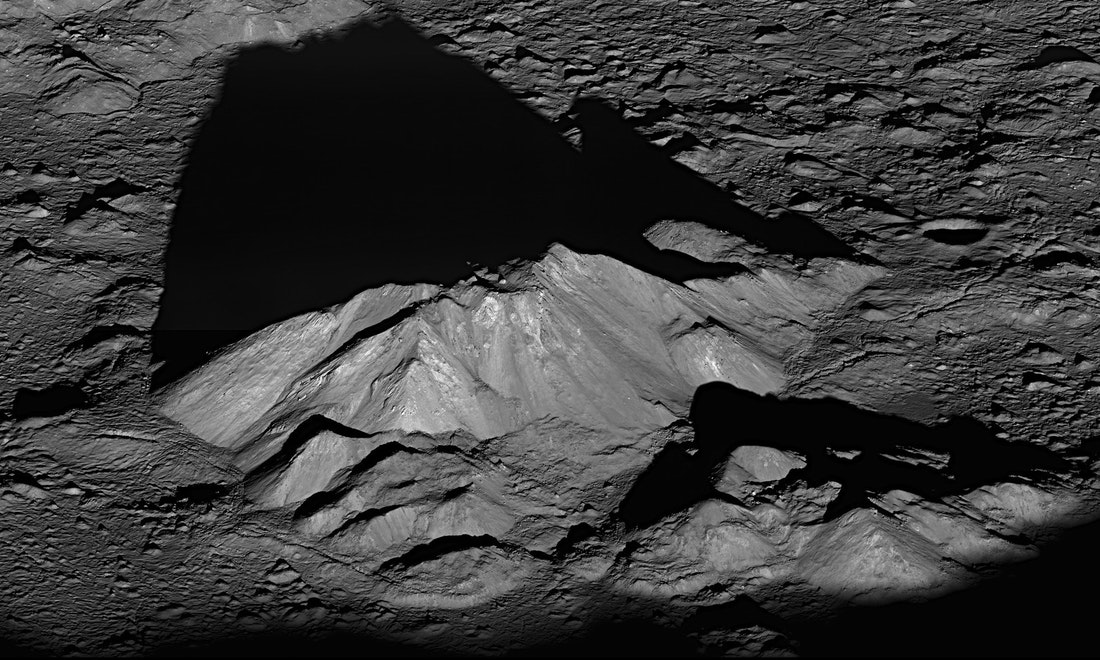meanderingexile
The world is a strange and lovely place.
Lunar Frosts and Turning Points

It’s often hard to know what we can do that will matter. The world is complicated, and we only know how things will be affected after the fact. The essence of strategy is to try to find leverage points, places and times that matter, where a small amount of effort can have a big impact.
I think that one of those points is a physical location where we can shape the direction of the coming years: the shadowed, icy bottoms of the craters that cluster near the lunar north and south poles. The recent burst of venture capital-funded commercial spaceflight is the spark; the polar water deposits will be the tinder. To understand why, we need to talk about a little bit of planetary geology.
Rock and Ice
The reason for the poles’ importance is rooted in the Moon’s fundamental orbital properties. In astrodynamics, the angle between the plane of an object’s orbit and the body’s axis of spin is called the axial tilt. The Earth’s generous axial tilt of 22 to 25 degrees gives us our seasons, especially at the Arctic and Antarctic, which experience months of daylight in summer followed by sunless winters. By contrast, the Moon only has an axial tilt of 1.5 degrees. An explorer resting against a rockface on Malapert Mountain, a hundred kilometers from the Lunar South Pole, would see the sun almost directly horizontal, with little variation with the time of year.
If the surface were flat, this would simply be an interesting factoid, but the lunar poles are anything but. The North Pole is pockmarked by hundreds of small, jagged craters, excavated by gigayears of asteroid impacts and untouched by weathering in the void of space. The South Pole is even more dramatic, dominated by several large impact craters within the greater Aitken Basin, crisscrossed by mountains on the scale of the Andes. With the sun lying so low in the horizon, the deeper craters and canyons tucked between these mountains have, quite literally, never seen direct sunlight. The temperatures inside are cryogenic, colder than liquid nitrogen, colder than the surface of Pluto. Rugged topography around the lunar South Pole. To explore this for yourself, check out the Arizona State University data viewer, located at: https://quickmap.lroc.asu.edu/.

Under these conditions, frozen water ice can exist, even in a hard vacuum. In 2009, the NASA LCROSS mission crashed a spent rocket stage into one of these sites, the Cabeus crater near the South Pole. A second followup spacecraft flew through the plume, and used a mass spectrometer to confirm the presence of water vapour. From this we know, at the very least, that there is a shallow layer of frost embedded on the surface of some of these craters.
There are a range of potential sources of hydrogen, oxygen, rocket propellants, and various other materials of interest on the Moon. What makes the polar surface frosts different is their simplicity of extraction. This doesn’t mean that it’s the most viable for long-term mining (this may depend on the deep crater ice deposits of Rubanenko, et al.) or the lowest-risk option for ISRU In-situ resource utilization, NASA-speak for a mission that takes advantage of something it finds at the site, rather than the traditional self-sufficient tin can approach. This also avoids unpleasant cultural associations with the word “mining”. (molten regolith extraction has strong arguments in its favor here). It does, however, have the least complexity, because it’s right there. The overburden (more simply, the dirt covering the stuff you care about) is thin, vastly reducing the tremendous civil engineering effort needed to construct open pit mines on Earth. Smelting this ore into our intermediate product (water) takes only a single step. Refining that water into rocket fuel takes a second step, electrolysis, that requires only electricity.
Boostrap Problems
Our first challenge is to create an entire economic infrastructure, from top to bottom, out of whole cloth. No gradual evolution from previous economic systems is possible, because there is no previous economic system. Each interdependent piece must be materialized simultaneously and in perfect working order; otherwise the system will crash out before it ever gets off the ground.
This simplicity is crucial because so much of space industrialization is an interlocking series of chicken and egg problems. Space People (an interesting cultural phenomenon in their own right) are drawn to space with something resembling religious fervor, some mix of instinctual migratory drive and ambition for the vast scale of possibility that the resources beyond our planet have to offer. In the short term, though, the reality is a lot closer to a critic’s description: expensive, complicated, and slow. Each of the aspirational visions we can argue for space (Mining with zero footprint on the biosphere! Solar power too cheap to meter! O’Neill cylinders filling the skies with life!) relies on a dozen other moving pieces, each stuck in the Catch 22 that the supply-side (mining, power, space station platforms, etc.) currently has insufficient demand, while the potential sources of demand are economically infeasible because they have to rely on expensive terrestrial logistics.
These problems are common (at a smaller scale, typically) in the startup space; as is often the case, Joel Spolsky has insightful comments that are worth reading https://www.joelonsoftware.com/2000/05/24/strategy-letter-ii-chicken-and-egg-problems/ . There are a range of specific technical strategies for solving these problems, but they all involve money and effort: the innovator soaks up costs, spends the money to ensure compatibility with existing systems, and incentivizes adoption out of their own pocket, in the hopes of profiting when their envisioned reality comes to pass. Someone has to front up this money and take a risk when others will not: this means deeper pockets, a higher risk appetite over a longer term, or both. Wearing an engineer’s hat, this is something we have limited control over That’s not to say that “become a high-net worth individual comparable to a nation-state” or “sway the cultural tides to create a civilization-wide mimetic feedback loop” are invalid strategies; they are, however, out of scope for this discussion. . Therefore, to maximize the chance that our goal comes to pass, we want to focus on narrowing the gap. The minimum-viable-product strategy is an example of this: all else being equal, the strategy that starts producing some kind of useful output and clarifies the shape of the future quicker is more likely to see the other side. If you’re resource-constrained, this is where to throw your engineering effort: how can we be more clever, and squeeze the gap?
Ignition Point
The single most important variable in the growth of the viability of space resources is, well, the viability of space resources: the ability to take advantage of off-world sources of propellant (and eventually other materials) cheaply and at scale is complimentary to essentially every off-world economic activity (our source of demand), including resource extraction itself. Kicking off this feedback loop is a necessary step to triggering an explosion in the cislunar economy. If we could trigger that feedback loop for free, we’d be on Alpha Centauri by now. Like so much in nature, though, it has an activation energy: the chicken-and-egg gap.
Given the potential space projects that get tossed around, water ice extraction from the lunar permanently shadowed regions is not the most intrinsically exciting or massively scalable option. Even as a resource base, they won’t last for long at any serious rate of consumption, and we’ll have to turn our attention to other options. What it does offer, however, is a chink in the armor of the bootstrapping problem: the possibility for a small team, using robotic systems, to land something that can eke out a little more propellant from the icy surface than it could have brought along itself, and hand it off to the next mission, which does the same.
This doesn’t instantly solve the chicken-and-egg problem: propellant profitability (more propellant coming out than you used to land your miner) doesn’t automatically correspond to financial profitability. That kind of market formation takes time, and you still need the resources to push through the gap.
What it does do, however, is create a situation of increasing marginal returns, where the underlying physical game (trading rocket fuel for more rocket fuel) is to your advantage. The longer you can just stay alive in that region, the more your situation improves. The availability of even a small amount of surplus in-space propellant makes every other mission infinitesimally more viable, which in turn makes the next extraction mission more justifiable.
Slowly, the fire grows.